Pain Management for Ankylosing Spondylitis: Comprehensive Guide
What are the best strategies for managing back pain due to ankylosing spondylitis? How can medications, physical therapy, and lifestyle changes help alleviate symptoms?
Comprehensive Strategies for Ankylosing Spondylitis Pain Management
Ankylosing spondylitis (AS) is a chronic inflammatory condition that primarily affects the spine, causing pain, stiffness, and potential fusion of the vertebrae. Effective pain management is crucial for individuals living with AS, as it can significantly improve their quality of life. This comprehensive guide explores the various strategies available to manage the debilitating back pain associated with this condition.
Medications for Ankylosing Spondylitis Pain Relief
Pharmacological interventions play a crucial role in managing the symptoms of ankylosing spondylitis. The most commonly used medications for pain relief include:
- Nonsteroidal Anti-Inflammatory Drugs (NSAIDs): These medications, such as ibuprofen and naproxen, help reduce inflammation and alleviate pain. High doses may be necessary to maintain symptom relief.
- Corticosteroids: These anti-inflammatory drugs can be administered orally or via localized injections to target specific joint or eye inflammation.
- Muscle Relaxants: These medications can help manage painful muscle spasms and improve mobility.
- Opioids: These powerful pain relievers may be used in cases where other medications are ineffective, but they carry a risk of addiction and should be closely monitored by a healthcare provider.
The Role of Physical Therapy in Ankylosing Spondylitis Pain Management
Physical therapy is an essential component of ankylosing spondylitis treatment, as it helps maintain flexibility, strength, and proper posture. A qualified physical therapist can develop a personalized exercise program that may include:
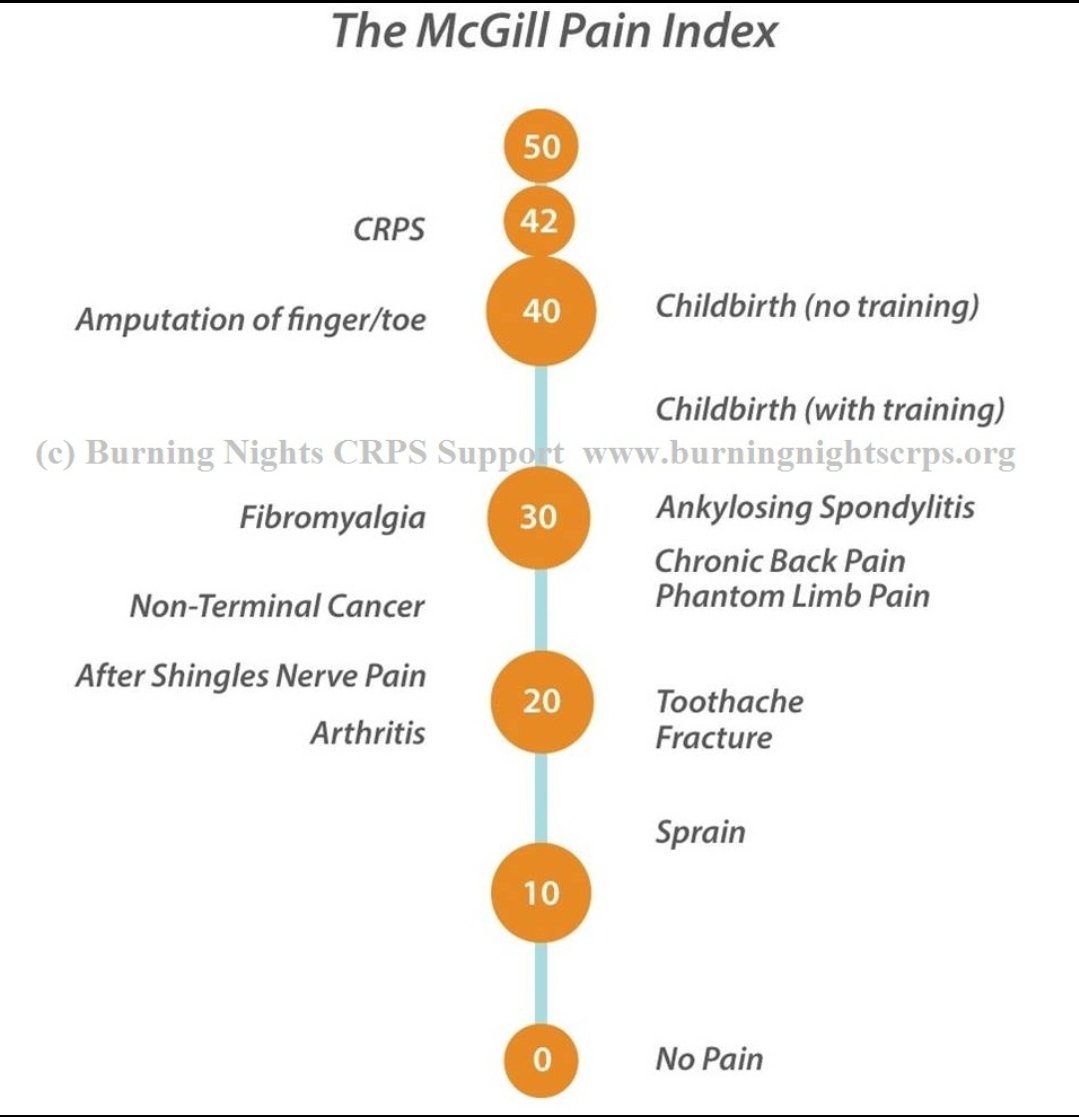
- Strength training to support the spine and improve overall muscle function
- Stretching and flexibility exercises to maintain range of motion
- Hydrotherapy, or exercising in water, to reduce joint stress and pain
- Posture training to prevent further spinal deformities
- Deep-breathing exercises to improve lung capacity and function
Lifestyle Modifications for Ankylosing Spondylitis Pain Relief
In addition to medical treatment, individuals with ankylosing spondylitis can take several steps to manage their pain and improve their overall well-being:
- Maintain a Healthy Weight: Excess weight places additional stress on the spine and joints, exacerbating pain.
- Practice Good Posture: Avoiding slouching or hunching can help prevent further spinal deformities and alleviate pain.
- Take Frequent Breaks: Regularly getting up and moving around can help reduce the stiffness and pain associated with prolonged sitting or standing.
- Quit Smoking: Smoking has been shown to worsen the progression of ankylosing spondylitis and make the condition more challenging to manage.
- Explore Anti-Inflammatory Diets: Certain foods, such as those high in omega-3 fatty acids, may have anti-inflammatory properties that can help ease symptoms.
The Importance of a Comprehensive Approach to Ankylosing Spondylitis Pain Management
Effectively managing the pain and symptoms associated with ankylosing spondylitis requires a multifaceted approach that combines pharmacological interventions, physical therapy, and lifestyle modifications. By working closely with a healthcare team and implementing a personalized treatment plan, individuals with AS can better control their symptoms, maintain their quality of life, and prevent further complications.

Ankylosing Spondylitis and Eye Complications: Addressing Uveitis
Approximately 40% of individuals with ankylosing spondylitis experience inflammation in the eyes, a condition known as uveitis. This complication can cause pain, redness, and vision problems. Corticosteroid eye drops are often used to reduce swelling and irritation in the eyes, while oral steroid medications may be prescribed to manage severe flare-ups.
The Importance of Adherence and Continuous Monitoring in Ankylosing Spondylitis Management
Effective pain management for ankylosing spondylitis requires a long-term commitment to the prescribed treatment plan. Patients must work closely with their healthcare providers to monitor their condition, adjust medications as needed, and consistently engage in physical therapy and lifestyle modifications. Regular check-ups and open communication between the patient and the medical team are essential for optimizing pain relief and maintaining overall well-being.
How to Manage Back Pain
Written by Jennifer Rainey Marquez
- Ways to Get Started
- Medicines to Control Pain When You’re Having a Flare
The best defense against back pain from ankylosing spondylitis (AS) is controlling your disease with a daily treatment plan. It will usually include medications your doctor recommends. When the pain is worse than normal and you’re having a flare, your doctor may have you try other drugs.
But you can take steps on your own, besides meds, to ease pain and stiffness.
Work with a physical therapist. Exercise is an important part of everyday treatment. When you strengthen the muscles that support your spine, you can boost your flexibility and lower pain.
It’s best to work with a qualified therapist. They can make sure your form is right. When some exercises are done the wrong way, they can make you feel worse.
A trainer can keep you on the right track and motivated. In addition to strength training and stretching, your program might include exercising in water (hydrotherapy), posture training, and deep-breathing exercises.
Having a flare? Use heat or ice. A physical therapist may recommend either hot or cold therapy.
You can use a cold pack on inflamed areas to help with swelling. And you can use heat to loosen up tight muscles and ease joint stiffness. Take a warm shower before a workout, for example, to help you move better.
Take frequent breaks. If you don’t move around a lot, your symptoms may be worse. If you have to sit for a long time at work, try to get up every hour or so to stretch or walk around. (Your doctor can write a note so that you can take regular breaks.)
Practice good posture. Hunching over may make back pain feel better for a short time. But it only strains your spine more. There is also a risk that your vertebrae — small, linked bones that form your backbone — could fuse in a bent-forward position.
Ask your spouse, co-worker, or friend to remind you to keep your back straight. If you work at a computer, make sure your station is set up to promote good posture.
Eat smart. Eating healthy food and watching your portions can control your weight, and that’s important. Extra pounds mean extra pressure on your spine and joints. While there’s no one diet that’s recommended for AS, foods with anti-inflammatory properties — such as those high in omega-3 fatty acids (like salmon) — could help.
Stop smoking. Lighting up makes AS more damaging and hard to treat. Ask your doctor about things that can help you ditch the habit.
Nonsteroidal anti-inflammatory drugs (NSAIDs). These include medications like ibuprofen and naproxen. NSAIDs, which lower inflammation, may be a part of your regular daily treatment plan. If they are, don’t take more than prescribed without talking with your doctor. If NSAIDs aren’t a part of your treatment plan, talk with your doctor about them.
Corticosteroids. If NSAIDs don’t do enough for your joint pain, your doctor may use these drugs. You might get shots into stiff, painful joints to help with swelling and give you temporary relief. But your doctor won’t recommend this too often because they can damage soft tissues and bone.
You might get shots into stiff, painful joints to help with swelling and give you temporary relief. But your doctor won’t recommend this too often because they can damage soft tissues and bone.
About 40% of people with ankylosing spondylitis have inflammation in their eyes (uveitis). If you have this, corticosteroid eye drops can lower swelling and ease irritation.
Steroid pills are also sometimes used to help with eye or joint flares.
Muscle relaxants. Your doctor may prescribe these to help with painful muscle spasms, ease stiffness, and make it easier to exercise. You’ll probably only take them for short times.
Opioids. While these drugs aren’t usually one of the first things your doctor will try, they can help with severe pain that doesn’t get better with NSAIDs or other treatments. Opioids can be habit-forming though, so you can’t take them for a long time, and it’s important for your doctor keep an eye on you while you take them.
Top Picks
Medications Used to Treat Ankylosing Spondylitis
There are a number of different types and classes of medications used in the treatment of ankylosing spondylitis and related diseases. Note that different people respond to different medications with varying levels of effectiveness. Thus, it may take time to find the most effective course of treatment.
See Our Medications Chart: An Updated Listing of Medications for Spondyloarthritis
Nonsteroidal Anti-Inflammatory Drugs (NSAIDs)
NSAIDs are the most commonly used class of medication for the treatment of pain and stiffness associated with spondyloarthritis. Ibuprofen, for instance, is a generic NSAID and is found in over-the-counter pain relievers such as Advil and Motrin.
Ibuprofen, for instance, is a generic NSAID and is found in over-the-counter pain relievers such as Advil and Motrin.
Sometimes, high doses of NSAIDs are needed to maintain relief from the symptoms of ankylosing spondylitis and related diseases. This can pose a problem because NSAIDs can cause significant side effects, especially in the gastrointestinal tract (stomach, intestines, etc.). NSAIDs can cause reduced amounts of protective mucus in the stomach, which can result in stomach irritation. Over time, this can lead to heartburn, gastritis, and possibly ulcers and even bleeding. People can take other medications (such as antacids) to neutralize or prevent the production of excess stomach acid, help coat and protect the stomach (such as Carafate), or restore the lost mucus (such as Cytotec).
There may also be an increased risk of heart attack or stroke associated with NSAIDs, especially in people with a history of heart diseases.
A different class of NSAIDs known as COX-2 inhibitors (or COXIBs) seem to reduce the risk of gastrointestinal complications associated with traditional NSAID therapy. Celebrex (Celecoxib) is still being used to treat spondyloarthritis. Others, such as Vioxx, were pulled from the market in 2004 because of the high rate of heart attacks caused by the drug.
Celebrex (Celecoxib) is still being used to treat spondyloarthritis. Others, such as Vioxx, were pulled from the market in 2004 because of the high rate of heart attacks caused by the drug.
When NSAIDs Are Not Enough
Sulfasalazine
Sulfasalazine is one medication that can be helpful to some people with severe disease. It is known to effectively control not only pain and joint swelling from arthritis of the small joints, but also the intestinal lesions in inflammatory bowel disease. It comes in tablet form and is taken orally. Sulfasalazine is generally not utilized for spinal arthritis.
Side effects are relatively infrequent, but can include headaches, abdominal bloating, nausea, and oral ulcers. Rarely, someone being prescribed this medication can develop bone marrow suppression, which is why it is important for your doctor to regularly monitor your blood count.
Methotrexate
Originally developed to treat cancer, this chemotherapy drug is widely used and often very effective for the treatment of rheumatoid arthritis. When prescribed for treating symptoms of spondyloarthritis, it is given in smaller doses and is generally not utilized for spinal arthritis. Methotrexate can either be taken via a self-injectable shot or orally in tablet form. When taking methotrexate, it is also necessary to take the vitamin folic acid in order to help suppress some of the possible side effects, including oral ulcers and nausea. Because of other potential serious side effects, frequent monitoring of blood counts and liver function are required. Methotrexate is strongly contraindicated in pregnant women, as it has caused birth defects and death in unborn babies.
When prescribed for treating symptoms of spondyloarthritis, it is given in smaller doses and is generally not utilized for spinal arthritis. Methotrexate can either be taken via a self-injectable shot or orally in tablet form. When taking methotrexate, it is also necessary to take the vitamin folic acid in order to help suppress some of the possible side effects, including oral ulcers and nausea. Because of other potential serious side effects, frequent monitoring of blood counts and liver function are required. Methotrexate is strongly contraindicated in pregnant women, as it has caused birth defects and death in unborn babies.
Corticosteroids
While corticosteroids such as prednisone can be effective in relieving inflammation, the side effects of long-term use of systemic corticosteroids (which impact the entire body) can be very severe. As such, experts strongly recommend against using oral or injectable systemic corticosteroids. In contrast, local injections into inflamed joints (which do not impact the entire body) are acceptable, and can provide temporary relief of the pain caused by arthritis or bursitis.
The Biologics
Biologic medications are made from living organisms. The material they are made from can come from many sources, including humans, animals, and microorganisms such as bacteria or yeast.
TNF Inhibitors
The tumor necrosis factor alpha (TNF-α) inhibitors were the first biologic medications to have shown great promise in treating spondyloarthritis, with the first TNF inhibitor – Enbrel – being approved in 2003. These medications have been shown to be highly effective in treating not only the arthritis of the joints, but also the inflammation in the gut and eyes, as well as the spinal arthritis associated with ankylosing spondylitis (AS), non-radiographic axial spondyloarthritis (nr-axSpA), and related diseases.
A serious and well-known complication of the TNF inhibitors is an increased frequency of infections, along with a reduced ability to fight infections, including tuberculosis. Thus, a TB test is required before starting any of the TNF therapies.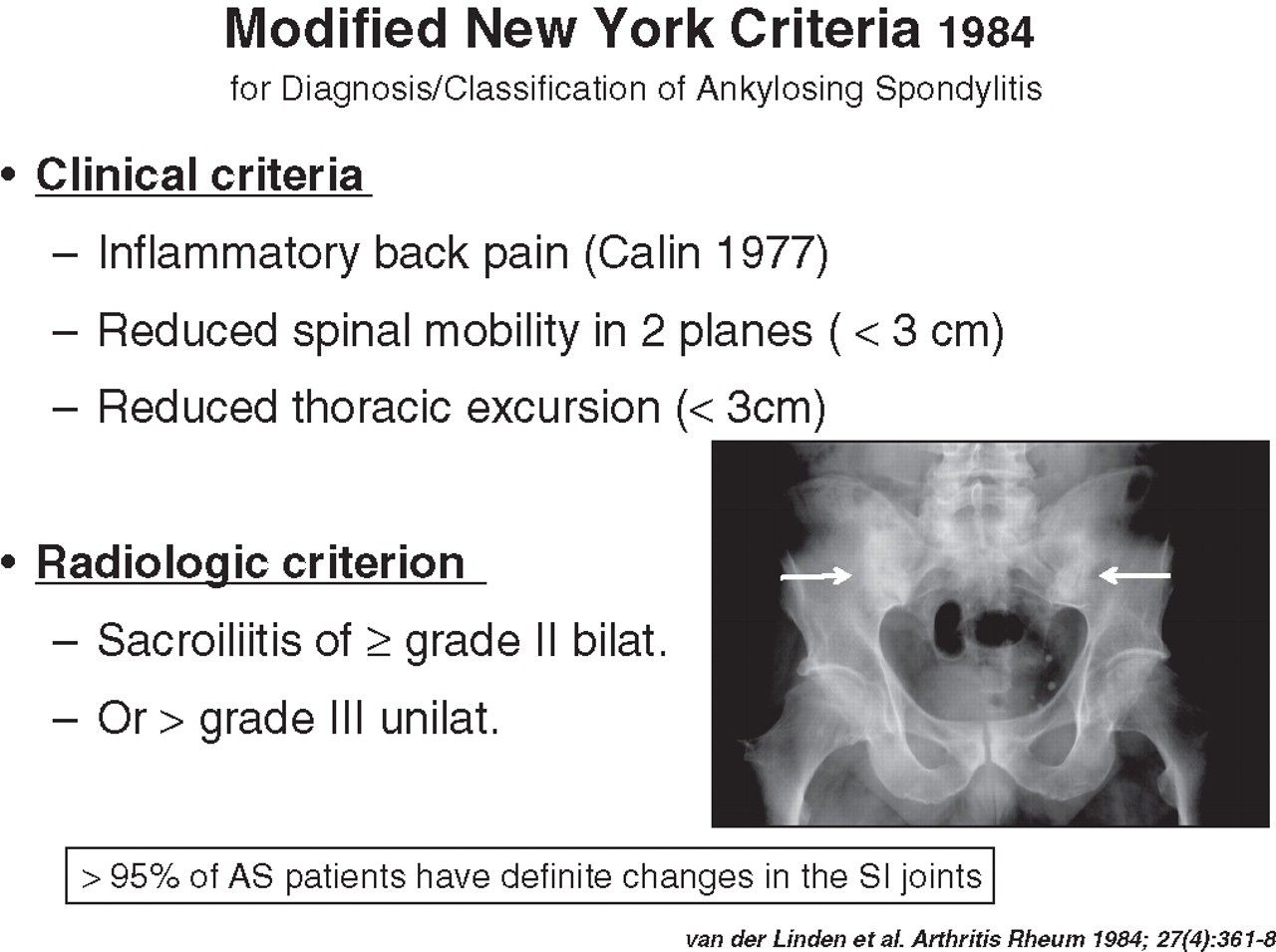 There is also a slightly increased risk of certain cancers associated with TNF inhibitors, such as lymphoma (most notably in children and teens) and skin cancers.
There is also a slightly increased risk of certain cancers associated with TNF inhibitors, such as lymphoma (most notably in children and teens) and skin cancers.
It should be noted that each TNF inhibitor/biologic medication works in a slightly different manner. Thus, if one does not have a positive effect, another one might.
The following TNF inhibitors are currently approved for forms of spondyloarthritis: Enbrel, Humira, Remicade, Simponi, and Cimzia.
IL-17 Inhibitors
IL-17 inhibitors are another class of biologic medications approved for spondyloarthritis. There are currently two IL-17 inhibitors approved by the FDA for forms of spondyloarthritis – specifically for ankylosing spondylitis (AS), non-radiographic axial spondyloarthritis (nr-axSpA), and psoriatic arthritis (PsA). Cosentyx (secukinumab) was approved for AS and PsA in January of 2016, and Taltz (ixekizumab) was approved for PsA in December of 2017, and for AS in August of 2019. Both were approved for nr-axSpA in June of 2020.:max_bytes(150000):strip_icc()/spondyloarthropathy-explained-190443-v1-bbdfdf523ae34c378ae1b0fcf59e9b60.jpg)
Both IL-17 and TNF-α are inflammatory cytokines (cell signaling molecules) that, as the name implies, signal to activate inflammation throughout the body, modulating or altering the immune system response. Inflammatory cytokines play an important role; however, when there is an overabundance of these, as has been described in inflammatory disease, they can cause harm to the body if left unchecked.
IL-17 and TNF-α cytokines signal to specific immune cells directing them to activate inflammation, with each cytokine being responsible for signaling to a different set of cells. IL-17 and TNF inhibitor medications work by targeting their respective cytokines, obstructing their signaling pathways, and by this mechanism seek to reduce inflammation. Since IL-17 inhibitors target different cytokines than the TNF inhibitors, the hope is that this newer class of biologic medications will help those who haven’t responded well to the TNF inhibitors, or are not able to tolerate them.
IL-17 inhibitors carry similar risks of infections, and reduced ability to fight infections as the TNF inhibitors. They have also shown in clinical trials to exacerbate inflammatory bowel disease in patients who have it, as well as bring on new cases of inflammatory bowel disease.
IL 12/23 Inhibitor
Ustekinumab (Stelara) works similarly to the IL-17 inhibitor, but targets different cytokines: IL-12 and IL-23. Stelara was approved in 2013 for psoriatic arthritis. Stelara also carries increased risks of infections, and reduced ability to fight infections, as well as a slightly increased risk of certain cancers.
JAK Inhibitors
Janus kinase (JAK) inhibitors, also known as JAKi, are the latest class of synthetic (non-biologic) disease-modifying anti-rheumatic drugs (DMARDs) that have been proven effective in the treatment of multiple forms of arthritis, including psoriatic arthritis (PsA), ankylosing spondylitis (AS), and non-radiographic axial spondyloarthritis (nr-axSpA). These medications are taken orally as pills, as opposed to biologics, which are injectable.
These medications are taken orally as pills, as opposed to biologics, which are injectable.
JAK inhibitors specifically target the JAK family of enzymes, namely JAK1, JAK2, JAK3, and tyrosine kinase 2 (TYK2), each of which are involved in the initiation of the signal for a cell to make more than 60 different cytokines and growth factors.
Unlike biologics, which inhibit the effects of one single cytokine, JAKi can block the effects of multiple cytokines that are implicated in the pathogenesis (development) of many immune-mediated rheumatic diseases, including AS. They have a shorter half-life compared to biologics, meaning they are active in the body for less time, which means if they are discontinued, any side effects will disappear in a quicker fashion.
Two JAKi are FDA-approved for ankylosing spondylitis (AS) and for psoriatic arthritis (PsA): tofacitinib (Xeljanz or Xeljanz XR) and upadacitinib (Rinvoq). Upadacitinib is also approved for non-radiographic axial spondyloarthritis (nr-axSpA).
Modern principles of therapy for ankylosing spondylitis | Kimova A.M.
The article presents modern principles of therapy for ankylosing spondylitis
For citation. Kimova A.M. Modern principles of therapy for ankylosing spondylitis // RMJ. 2015. No 25. S. 1499–1503.
Ankylosing spondylitis (AS) (Bekhterev’s disease, Strümpel-Marie-Bekhterev’s disease) is a chronic inflammatory disease of the spine (spondylitis), sacroiliac joints (sacroiliitis), often peripheral joints (arthritis), enthesis (enthesitis), in some cases – eyes (uveitis), cardiovascular system – aortic root (aortitis), other internal organs.
This disease was known in ancient Egypt. The first descriptions of AS in foreign literature were made by A. Strümpel (1884) and P. Marie (1898) and were regarded as a variant of chronic articular rheumatism [1]. In the domestic literature, priority is given to V.M. Bekhterev, although the clinical picture of patients with “stiffness of the spine”, described by Bekhterev, differed from the classical AS clinic.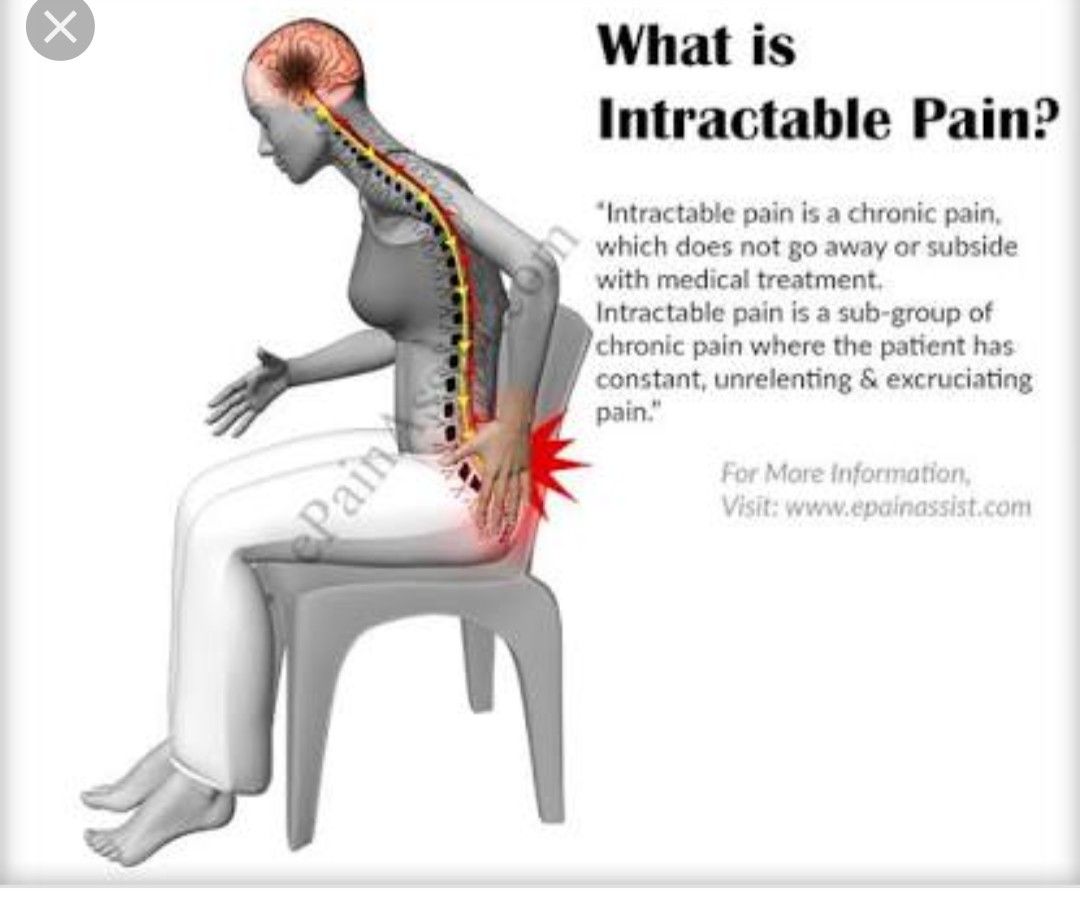 However, V.M. Bekhterev drew great attention to the problem of AS, which served as an impetus for the study of AS and other spondyloarthritis [2].
However, V.M. Bekhterev drew great attention to the problem of AS, which served as an impetus for the study of AS and other spondyloarthritis [2].
Classification modified New York criteria for the diagnosis of AS (1984):
1. Pain and stiffness in the lower back – more than 3 months, decreasing after exercise and aggravated at rest.
2. Limitation of movements in the lumbar spine in the sagittal and frontal planes.
3. Decreased chest excursion (compared to normal values for gender and age).
4. Bilateral sacroiliitis 2-4 stages or unilateral sacroiliitis 3-4 stages.
The diagnosis of definite AS is established in the presence of radiological and at least 1 clinical criterion [3].
The disease can begin in childhood, but the peak falls on the 3rd decade (usually no later than 40 years). Men get sick 2-3 times more often than women. In more than 90% of cases, the genetic marker HLA-B27 is detected. Despite the fact that the clinical picture of AS was described half a century ago, the diagnosis of AS is established, on average, 7–10 years after the onset of the first manifestations. This is due to a number of reasons such as:
This is due to a number of reasons such as:
– variety of the clinical picture at the onset of the disease;
– non-vertebral lesions, in connection with which patients turn to various specialists;
– slow development of radiological signs of sacroiliitis, which are of decisive importance;
– spontaneous long-term remissions in the first years of the disease;
– absence of immunological markers;
– non-permanent increase in ESR and CRP in the first months and years of AS;
– lack of sufficient knowledge about the debut of AS among doctors of other specialties.
The clinical picture of AS does not depend on gender and the presence of HLA-B27. In about 25% of cases, the disease appears in childhood. Not always AS begins with spondylitis or sacroiliitis.
Variants of disease onset
Spinal injury
Damage to the spine usually begins with the sacroiliac joints with a gradual transition to the overlying sections.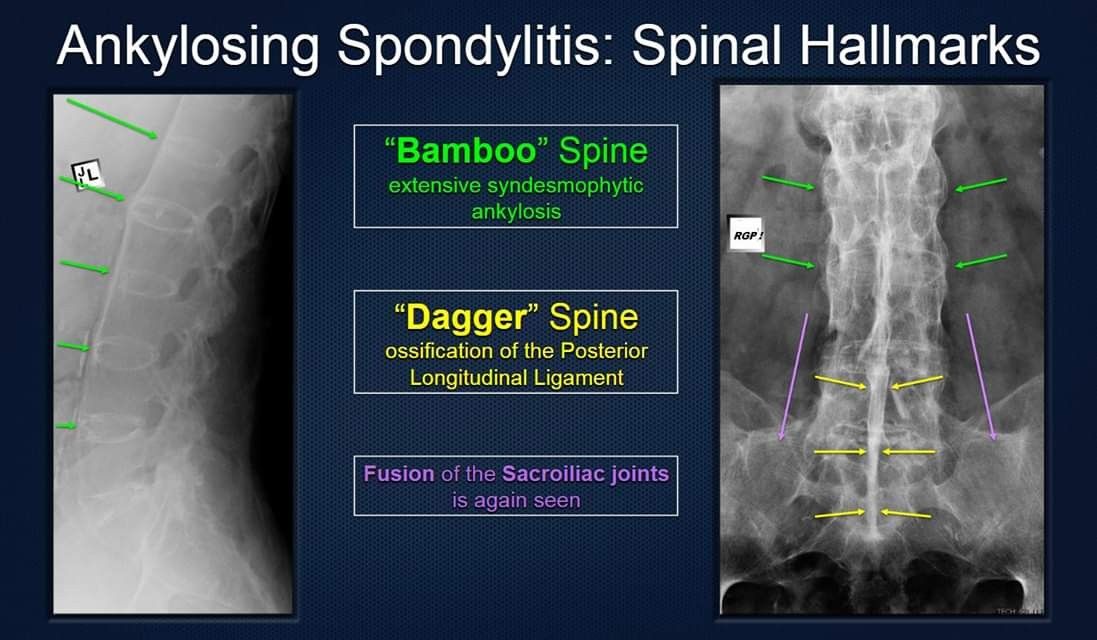 Sacroiliitis is manifested by intermittent pain in the buttocks, radiating to the gluteal folds, along the back of the thigh, to the inguinal region. Gradually, the pain increases, becomes bilateral. Inflammatory pain in the lower back is also characteristic of the early stage of the disease, for the diagnosis of which the following criteria have been developed:
Sacroiliitis is manifested by intermittent pain in the buttocks, radiating to the gluteal folds, along the back of the thigh, to the inguinal region. Gradually, the pain increases, becomes bilateral. Inflammatory pain in the lower back is also characteristic of the early stage of the disease, for the diagnosis of which the following criteria have been developed:
– age of onset of pain – earlier than 40 years;
– gradually increasing current;
– reduction of pain after exercise;
– lack of improvement at rest;
– night pain.
Pain is considered inflammatory if 4 out of 5 signs are present. With AS, all parts of the spine are involved in the process. The disease often occurs under the guise of lumbosacral sciatica. With damage to the thoracic spine, costovertebral joints, there is pain in the chest, sometimes girdle character. The pain is aggravated by coughing, taking a deep breath, turning. The defeat of the costovertebral joints helps to reduce the excursion of the chest, which further leads to a decrease in the vital capacity of the lungs. The defeat of the cervical spine occurs at a later date and leads to a decrease in the volume of movement of the head and neck. Cervical spondylitis may be accompanied by symptoms of discirculatory encephalopathy. Pain in the spine reflexively causes muscle spasm, which leads to limited mobility of the spine. In the early stages of the disease, the limitation of the range of motion in the spine is due to inflammation and reflex spasm of the muscles against the background of pain; at the stage of advanced clinical manifestations, movements are limited due to ossification of the spine. Over time, as a result of an inflammatory lesion of the spine, changes in posture occur that are characteristic of AS: the posture of the “beggar”, the posture of the “proud”.
The defeat of the cervical spine occurs at a later date and leads to a decrease in the volume of movement of the head and neck. Cervical spondylitis may be accompanied by symptoms of discirculatory encephalopathy. Pain in the spine reflexively causes muscle spasm, which leads to limited mobility of the spine. In the early stages of the disease, the limitation of the range of motion in the spine is due to inflammation and reflex spasm of the muscles against the background of pain; at the stage of advanced clinical manifestations, movements are limited due to ossification of the spine. Over time, as a result of an inflammatory lesion of the spine, changes in posture occur that are characteristic of AS: the posture of the “beggar”, the posture of the “proud”.
Peripheral joint disease
Peripheral arthritis is noted throughout the disease in more than half of patients and begins mainly with the joints of the lower extremities. The most commonly affected are the hip, knee, ankle joints, less often the temporomandibular, metatarsophalangeal, and shoulder joints.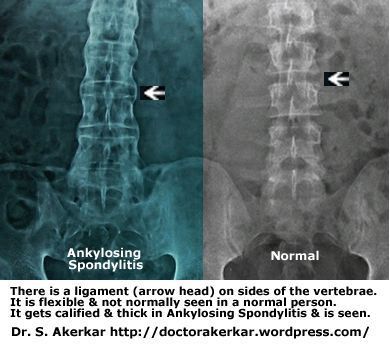 Peripheral arthritis of any localization is a serious problem due to severe pain, as well as due to the destruction of the articular surfaces and dysfunction. The most unfavorable in terms of prognosis is coxitis, often bilateral. It often develops in patients who fell ill in childhood [8]. Peripheral arthritis in AS is often associated with enthesitis.
Peripheral arthritis of any localization is a serious problem due to severe pain, as well as due to the destruction of the articular surfaces and dysfunction. The most unfavorable in terms of prognosis is coxitis, often bilateral. It often develops in patients who fell ill in childhood [8]. Peripheral arthritis in AS is often associated with enthesitis.
Enthesites
Inflammation of entheses in AS is natural. In AS, enthesitis is manifested by pain during movement, in which the corresponding tendon is involved, soreness, and sometimes swelling of the area of enthesis. Enthesitis usually appears in the heel, elbow, knee, shoulder and hip joints. The underlying bone (osteitis) is involved in the inflammatory process, which leads to the development of erosions and further ossification and excessive bone formation. These phenomena underlie the appearance of peculiar radiographic changes characteristic of AS: extra-articular bone erosion, subchondral osteosclerosis, bone proliferation (“spurs”) and periostitis. In AS, extraskeletal lesions are observed: uveitis, changes in the aorta and heart, kidney damage.
In AS, extraskeletal lesions are observed: uveitis, changes in the aorta and heart, kidney damage.
Uveitis
The frequency of uveitis in systemic rheumatic diseases ranges from 25 to 50%. Uveitis is the most common extraskeletal manifestation of AS; it can be a manifestation and for a long time the only manifestation of the disease. Uveitis begins acutely and lasts up to 3 months, has a relapsing character, can affect all parts of the uveal tract. Both eyes can be involved alternately in the process. Patients have pain in the eye, photophobia, lacrimation, conjunctival hyperemia. The development of complications leads to a decrease in vision and blindness at a young, working age. Blindness and low vision can account for 10 to 35% of eye diseases [9].
Damage to the heart and aorta
Damage to the heart and aorta determines the prognosis of the disease and the tactics of therapeutic measures. It is known that there is no relationship between activity and severity of damage to the musculoskeletal system. Despite the fact that damage to the cardiovascular system often proceeds subclinically, damage to the aorta and aortic valves is found in 24–100% of cases on section [4, 11].
Despite the fact that damage to the cardiovascular system often proceeds subclinically, damage to the aorta and aortic valves is found in 24–100% of cases on section [4, 11].
Early diagnosis of AS allows avoiding unnecessary examinations and protecting patients from improper therapy, including surgical manipulations, orienting the patient to the systematic use of non-steroidal anti-inflammatory drugs (NSAIDs), and in case of an unfavorable prognosis of AS, prescribing tumor necrosis factor inhibitors (anti- TNF-therapy) at an early stage. Training in physiotherapy exercises and a healthy lifestyle contributes to a more favorable outcome of AS.
Treatment of AS
It should be based on the clinical signs of the disease present at the time of examination (vertebral, articular, enthesis symptoms), their severity, the presence of prognosis indicators: disease activity / inflammation, functionality / disability, structural damage, involvement of the hip joints, spinal deformity, general clinical status (age , gender, comorbidities and therapy), patient expectations and preferences. The management of a patient with AS requires a mandatory combination of non-pharmacological and pharmacological methods of treatment.
The management of a patient with AS requires a mandatory combination of non-pharmacological and pharmacological methods of treatment.
Non-drug treatments
Non-drug methods of treatment include daily performance of a set of physical exercises aimed at maintaining a sufficient range of motion in the spine and large joints, strengthening skeletal muscles [12]; breathing exercises, back massage, physiotherapeutic procedures with various anti-inflammatory ointments in the form of phonophoresis, balneotherapy: radon and hydrogen sulfide baths. The functional state of the spine in people who regularly engage in exercise therapy and muscle training is better than in patients who neglect exercise for one reason or another. Non-pharmacological methods for AS may include educational programs – schools for patients. They can be done both individually and in groups. Non-pharmacological treatments for AS are only of secondary importance.
Pharmacological treatments
Pharmacological methods of treatment combine drugs from several groups: NSAIDs, muscle relaxants, corticosteroids, anti-TNF therapy.
NSAIDs
Despite the long history of the use of NSAIDs in the practice of rheumatology, in the current EULAR/ASAS recommendations, they are still first-line drugs in the treatment of AS, since they are distinguished by a unique combination of analgesic, anti-inflammatory, and antipyretic effects [5]. The long-term use and high efficacy of NSAIDs in relation to inflammatory pain raises the question of their ability to have not only symptomatic, but also disease-modifying effects, i.e., slowing radiographic progression. A recent observation by A. Wanders et al. confirmed that NSAIDs can slow down radiographic progression (ossification) in the spine. According to this study, it turned out that the average values of radiological changes were significantly less in patients who took NSAIDs constantly, and not on demand. However, it has not been established what influences the slowing down of spinal ossification: the suppression of active inflammation or the direct effect of NSAIDs on bone tissue – the suppression of osteoblast activity.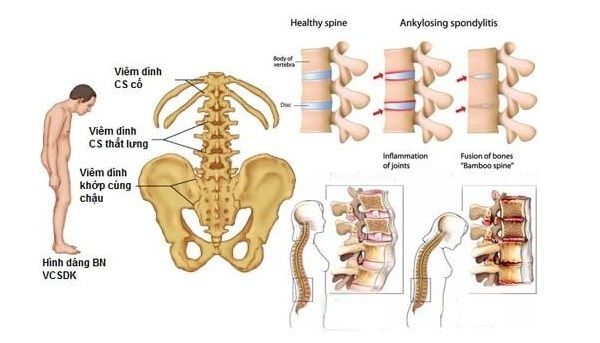 According to morphological studies, inflammation in the area of enthesis and bone (osteitis) in AS continues throughout the entire disease and does not tend to completely subside even when ankylosing of the spine or joint occurs, which is the basis for long-term use of this group of drugs. After establishing the diagnosis of AS (regardless of the stage of the disease), NSAIDs should be administered to the patient immediately. AS is the only rheumatological disease in which long-term use of NSAIDs is pathogenetically justified, highly effective and has no alternative, except for TNF-a inhibitors. The first goal of prescribing NSAIDs is to relieve pain. This is usually achieved within 2 weeks. If the main symptoms of the disease are night pain in the spine and morning stiffness, then it is desirable to prescribe prolonged forms of drugs. Sometimes, to eliminate pain and morning stiffness, a sequential change of 2-3 drugs is necessary.
According to morphological studies, inflammation in the area of enthesis and bone (osteitis) in AS continues throughout the entire disease and does not tend to completely subside even when ankylosing of the spine or joint occurs, which is the basis for long-term use of this group of drugs. After establishing the diagnosis of AS (regardless of the stage of the disease), NSAIDs should be administered to the patient immediately. AS is the only rheumatological disease in which long-term use of NSAIDs is pathogenetically justified, highly effective and has no alternative, except for TNF-a inhibitors. The first goal of prescribing NSAIDs is to relieve pain. This is usually achieved within 2 weeks. If the main symptoms of the disease are night pain in the spine and morning stiffness, then it is desirable to prescribe prolonged forms of drugs. Sometimes, to eliminate pain and morning stiffness, a sequential change of 2-3 drugs is necessary.
The most effective drugs for the treatment of AS are the classic (standard) drugs: diclofenac, indomethacin, ketoprofen, naproxen.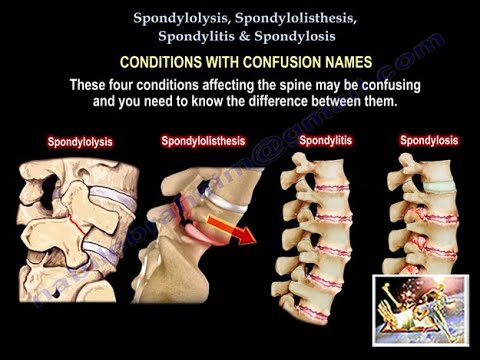 However, the frequency of adverse reactions in this group of drugs, especially with long-term use, which is required in the treatment of AS, makes preference for selective COX-2 inhibitors. In turn, moderately selective (meloxicam, nimesulide, nabumetone, etodolac) and highly selective (celecoxib, valdecoxib, etoricoxib, lumirocoxib) stand out among the latter. The choice of drug should be based on an analysis of the advantages and disadvantages of various groups of NSAIDs, taking into account the presence of analgesic, anti-inflammatory effects in combination with good tolerability (safety in relation to the gastrointestinal tract (GIT) and the cardiovascular system). In Russia, many experts consider nimesulide (Nise) to be a drug with these properties. The advantages of this drug are also noted by many world experts. In an article dedicated to the 25th anniversary of the use of nimesulide in Italy, C. Mattia et al. pointed to the obvious predominance of the positive qualities of this drug [6].
However, the frequency of adverse reactions in this group of drugs, especially with long-term use, which is required in the treatment of AS, makes preference for selective COX-2 inhibitors. In turn, moderately selective (meloxicam, nimesulide, nabumetone, etodolac) and highly selective (celecoxib, valdecoxib, etoricoxib, lumirocoxib) stand out among the latter. The choice of drug should be based on an analysis of the advantages and disadvantages of various groups of NSAIDs, taking into account the presence of analgesic, anti-inflammatory effects in combination with good tolerability (safety in relation to the gastrointestinal tract (GIT) and the cardiovascular system). In Russia, many experts consider nimesulide (Nise) to be a drug with these properties. The advantages of this drug are also noted by many world experts. In an article dedicated to the 25th anniversary of the use of nimesulide in Italy, C. Mattia et al. pointed to the obvious predominance of the positive qualities of this drug [6]. These conclusions are confirmed by clinical studies of scientists from NIIR them. V.A. Nasonova – A.E. Karateev et al. Retrospective analysis of the incidence of complications from the gastrointestinal tract, cardiovascular system and liver in patients admitted to the NIIR from 2007 to 2008 and taking nimesulide at a dose of 200 mg for at least 12 months. before admission, showed that in addition to effective analgesic, anti-inflammatory properties, the drug Nise has good tolerance. Nimesulide has proven to be an effective pain reliever. It has high bioavailability – within 30 minutes after oral administration, a significant concentration of the drug in the blood is reached, which is at least 25% of the maximum. The full analgesic and anti-inflammatory effect of nimesulide occurs 1-3 hours after administration.
These conclusions are confirmed by clinical studies of scientists from NIIR them. V.A. Nasonova – A.E. Karateev et al. Retrospective analysis of the incidence of complications from the gastrointestinal tract, cardiovascular system and liver in patients admitted to the NIIR from 2007 to 2008 and taking nimesulide at a dose of 200 mg for at least 12 months. before admission, showed that in addition to effective analgesic, anti-inflammatory properties, the drug Nise has good tolerance. Nimesulide has proven to be an effective pain reliever. It has high bioavailability – within 30 minutes after oral administration, a significant concentration of the drug in the blood is reached, which is at least 25% of the maximum. The full analgesic and anti-inflammatory effect of nimesulide occurs 1-3 hours after administration.
As is known, the pharmacological action of all NSAIDs is associated with the blockade of COX-2, and the gastrointestinal complications associated with their use are mainly determined by the suppression of COX-1 activity in the gastrointestinal mucosa. But COX-1 is also involved in the development of inflammation, and therefore a local decrease in its activity in the area of damage should be considered as a positive factor. Nimesulide has such an effect – it only slightly affects the “structural” COX-1 of the gastric mucosa, but significantly reduces the effects of this enzyme in the area of inflammation. Recently, the question of the central effects of NSAIDs associated with their ability to penetrate the tissue of the central nervous system and influence the development of a number of links in the pathogenesis of chronic pain associated with the activation of the central pain system (the phenomenon of “central sensitization”) has been actively discussed. Nimesulide obviously has such an effect, which is confirmed by the data of experimental and clinical studies. There is good reason to believe that nimesulide has a number of pharmacological effects independent of class-specific effects on COX-2. In particular, it suppresses the hyperproduction of the main pro-inflammatory cytokines (interleukin-6, TNF-a), reduces the activity of metalloproteinases.
But COX-1 is also involved in the development of inflammation, and therefore a local decrease in its activity in the area of damage should be considered as a positive factor. Nimesulide has such an effect – it only slightly affects the “structural” COX-1 of the gastric mucosa, but significantly reduces the effects of this enzyme in the area of inflammation. Recently, the question of the central effects of NSAIDs associated with their ability to penetrate the tissue of the central nervous system and influence the development of a number of links in the pathogenesis of chronic pain associated with the activation of the central pain system (the phenomenon of “central sensitization”) has been actively discussed. Nimesulide obviously has such an effect, which is confirmed by the data of experimental and clinical studies. There is good reason to believe that nimesulide has a number of pharmacological effects independent of class-specific effects on COX-2. In particular, it suppresses the hyperproduction of the main pro-inflammatory cytokines (interleukin-6, TNF-a), reduces the activity of metalloproteinases.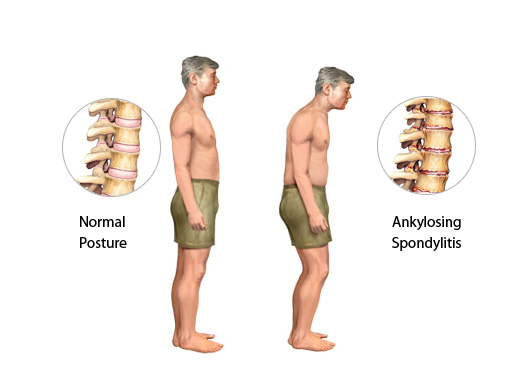
The effectiveness of nimesulide for the relief of acute and chronic pain in rheumatic diseases (RD) is confirmed by a series of clinical trials. Thus, there is evidence of its use in postoperative pain relief. In acute rheumatic inflammation of the periarticular soft tissues – enthesitis, bursitis and tendonitis, it demonstrates a good therapeutic effect, comparable or more pronounced than the effect of high doses of “traditional” NSAIDs – diclofenac and naproxen. In particular, W. Wober et al. conducted a study in which 122 patients with subacromial bursitis and tendonitis took nimesulide 200 mg/day or diclofenac 150 mg/day for 14 days. At the same time, a “good” or “excellent” response to treatment was somewhat more often observed in persons taking nimesulide – 82.3%, compared with 78.0% in the diclofenac group. A subjective assessment of the tolerance of the drugs used showed an even more pronounced advantage of nimesulide: 96.8% of patients rated its tolerability as “good” or “excellent”, while only 72. 9% gave a similar assessment to diclofenac [14].
9% gave a similar assessment to diclofenac [14].
Nimesulide is effective for acute low back pain (LBP). According to a clinical trial conducted by Finnish scientists, nimesulide at a dose of 100 mg 2 times a day was superior to ibuprofen at a dose of 600 mg 3 times a day, both in terms of the severity of the analgesic effect and in restoring the function of the spine. By the 10th day of therapy, the use of nimesulide provided an improvement in functional activity by more than 2 times. This makes nimesulide (Nise) very attractive for the treatment of pain in Bechterew’s disease.
One of the most valuable advantages of nimesulide for clinical practice is its good gastrointestinal tolerance. After all, it is the development of the pathology of the digestive system, which is one of the class-specific complications of NSAIDs, that is one of the main parameters that determine the risk-benefit ratio for this class of painkillers.
The risk of liver complications when using nimesulide (Nise) is not higher than that of “traditional” NSAIDs. An analysis of the available literature data and clinical studies shows that the negative dynamics of laboratory biochemical parameters, indicating the development of liver pathology, is observed with the use of nimesulide with the same frequency as with other NSAIDs. When analyzing reports of hepatotoxic reactions, it turned out that the total number of reports when using diclofenac was 990, ibuprofen – 590, and nimesulide – only 152. Most importantly, a life-threatening pathology – liver failure was recorded by WHO in 21 patients who received diclofenac, and in 32 patients who received ibuprofen. Against the background of taking nimesulide, this complication was noted only in 4 cases. It becomes clear that complications from the liver when using nimesulide are extremely rare, and their absolute number in comparison with other popular NSAIDs is very small.
An analysis of the available literature data and clinical studies shows that the negative dynamics of laboratory biochemical parameters, indicating the development of liver pathology, is observed with the use of nimesulide with the same frequency as with other NSAIDs. When analyzing reports of hepatotoxic reactions, it turned out that the total number of reports when using diclofenac was 990, ibuprofen – 590, and nimesulide – only 152. Most importantly, a life-threatening pathology – liver failure was recorded by WHO in 21 patients who received diclofenac, and in 32 patients who received ibuprofen. Against the background of taking nimesulide, this complication was noted only in 4 cases. It becomes clear that complications from the liver when using nimesulide are extremely rare, and their absolute number in comparison with other popular NSAIDs is very small.
In 2013, the absence of specific hepatotoxicity of nimesulide was confirmed by another population-based study. S. Gulmez et al. studied the causes of acute liver failure in 9479 people included in the list in need of emergency liver transplantation (European Union, 2005–2007). NSAIDs were the etiological factor of this potentially fatal complication in 40 cases, paracetamol – in 192. The relative risk (RR) of acute liver failure for different drugs is different. According to the results of the study, nimesulide was less dangerous than paracetamol and ibuprofen, and actually equal to such drugs as diclofenac and ketoprofen. In Russia, not a single case of severe hepatotoxic reactions has been described [7].
studied the causes of acute liver failure in 9479 people included in the list in need of emergency liver transplantation (European Union, 2005–2007). NSAIDs were the etiological factor of this potentially fatal complication in 40 cases, paracetamol – in 192. The relative risk (RR) of acute liver failure for different drugs is different. According to the results of the study, nimesulide was less dangerous than paracetamol and ibuprofen, and actually equal to such drugs as diclofenac and ketoprofen. In Russia, not a single case of severe hepatotoxic reactions has been described [7].
An important factor contributing to the popularity of nimesulide among other drugs of this drug group is its low cost, which makes it affordable for the vast majority of the inhabitants of our country. After all, the main consumers of NSAIDs are patients suffering from chronic diseases of the joints and spine, elderly people with low income.
In addition to standard forms for oral administration, a preparation for local use is also presented – Nise gel containing 1% of the active substance. Local forms of NSAIDs are a useful and safe agent that can be used for adjuvant therapy both when applied to the skin and in the form of phonophoresis with an ointment on the painful area [13].
Local forms of NSAIDs are a useful and safe agent that can be used for adjuvant therapy both when applied to the skin and in the form of phonophoresis with an ointment on the painful area [13].
Glucocorticosteroids (GCS)
For the treatment of AS, systemic use of corticosteroids is not recommended. But these drugs are effective as local therapy for peripheral arthritis in recurrent synovitis. The effectiveness of HA in the treatment of AS is beyond doubt, but they are less effective in the treatment of enthesitis (apparently due to the lower concentration of the active substance in the avascular zone of enthesis). In these cases, local injections of corticosteroids into the enthesis zone are highly effective.
Muscle relaxants
It is known that pain in the spine is accompanied by muscle spasm, the presence of which in turn exacerbates pain and spasm. It has been established that the simultaneous use of NSAIDs and muscle relaxants reduces back pain and also helps to maintain spinal mobility [7].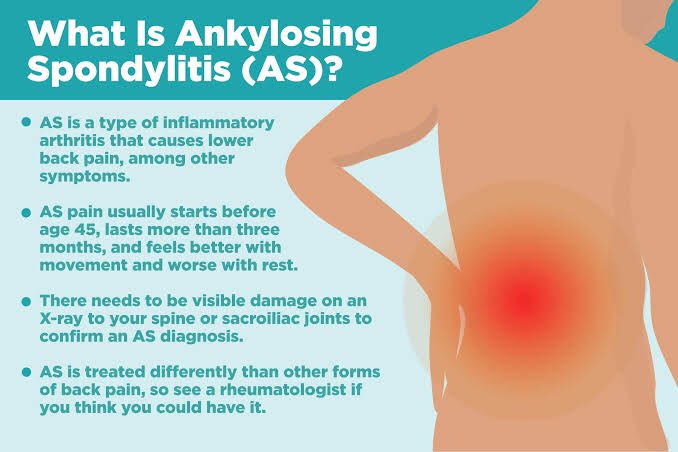
DMARDs
Synthetic DMARDs: sulfasalazine, methotrexate, leflunomide are not recommended in the treatment of axial forms of AS due to inefficiency. But in peripheral arthritis, this group of drugs is used with a positive effect, which is recommended to be evaluated no earlier than after 3 months. Sulfasalazine is taken in a daily dose of 2-3 g. The use of methotrexate, depending on the effectiveness, toxicity, can be at a dose of 10 to 15-20 mg per week and must be accompanied by folic acid intake, excluding the day of methotrexate intake. In case of intolerance to methotrexate, the patient may be prescribed Arava. The latter is taken at 20 mg/day after a 3-day induction dose of 100 mg/day for 3 days.
Genetically engineered biological products (GIBPs)
Recently, significant progress has been made in the treatment of diseases of the joints and spine due to the use of GEBP. The high efficiency of this group of drugs has been confirmed by numerous studies and long-term use in medical practice.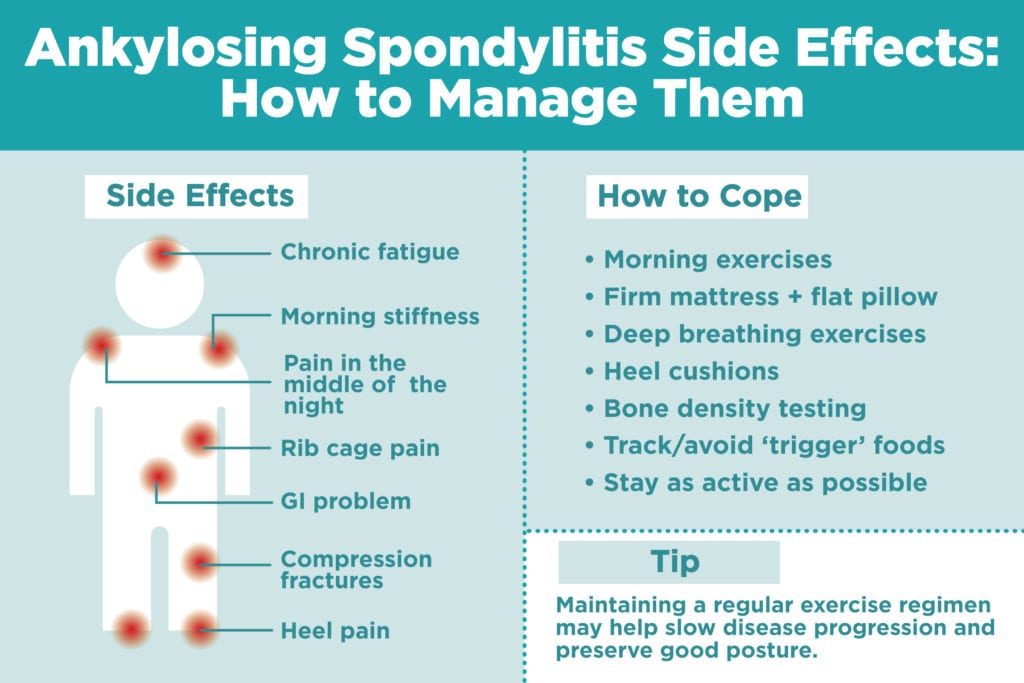 In AS, these drugs provide a distinct reduction in pain and inflammation in the spine, joints, and entheses. Approved drugs for the treatment of AS include infliximab, adalimumab, etanercept, golimumab, and certolizumab pegol. A fundamental difference in the effectiveness of these drugs in relation to the effect on the main symptoms (pain, stiffness, enthesitis, peripheral arthritis) has not been established. Treatment with GIBD should be started if there is no effect in the treatment of both NSAIDs and NSAIDs in combination with DMARDs (sulfasalazine at a maximum dose of 3 g / day) for 3 months. The effect of TNF-a inhibitors on uveitis (as opposed to the effects on the spine and peripheral arthritis) has been little studied. A group of employees of the NIIR them. V.A. Nasonova (A.A. Godzenko, A.G. Bochkova, Sh.F. Erdes et al.) studied the effect of TNF-a inhibitors: infliximab, adalimumab, and etanercept on the frequency of uveitis attacks in patients with AS. As a result of the study, it was found that TNF-a inhibitors effectively affect uveitis in patients with AS.
In AS, these drugs provide a distinct reduction in pain and inflammation in the spine, joints, and entheses. Approved drugs for the treatment of AS include infliximab, adalimumab, etanercept, golimumab, and certolizumab pegol. A fundamental difference in the effectiveness of these drugs in relation to the effect on the main symptoms (pain, stiffness, enthesitis, peripheral arthritis) has not been established. Treatment with GIBD should be started if there is no effect in the treatment of both NSAIDs and NSAIDs in combination with DMARDs (sulfasalazine at a maximum dose of 3 g / day) for 3 months. The effect of TNF-a inhibitors on uveitis (as opposed to the effects on the spine and peripheral arthritis) has been little studied. A group of employees of the NIIR them. V.A. Nasonova (A.A. Godzenko, A.G. Bochkova, Sh.F. Erdes et al.) studied the effect of TNF-a inhibitors: infliximab, adalimumab, and etanercept on the frequency of uveitis attacks in patients with AS. As a result of the study, it was found that TNF-a inhibitors effectively affect uveitis in patients with AS. The three drugs studied (infliximab, adalimumab, etanercept) significantly reduced the incidence of uveitis exacerbations compared to standard anti-inflammatory therapy. The criteria for evaluating response to treatment are a global assessment of the patient’s well-being using a 100-mm visual analog scale (VAS), pain in the spine using the VAS, a functional assessment of the patient (BASFI), and an assessment of inflammation using the BASDAI questionnaire [1, 10].
The three drugs studied (infliximab, adalimumab, etanercept) significantly reduced the incidence of uveitis exacerbations compared to standard anti-inflammatory therapy. The criteria for evaluating response to treatment are a global assessment of the patient’s well-being using a 100-mm visual analog scale (VAS), pain in the spine using the VAS, a functional assessment of the patient (BASFI), and an assessment of inflammation using the BASDAI questionnaire [1, 10].
Surgery
In cases of involvement in the process of the hip joints with the development of coxitis and subsequent functional disorders in patients, arthroplasty of the hip joint can be performed. Spinal surgery (corrective osteotomy) may be performed if necessary.
Despite significant progress in the treatment of AS in recent years, many unresolved problems remain: monitoring of patients, the immunogenicity of GEBAs and their impact on the efficacy and safety of therapy, etc. This leaves the tactics of managing and treating patients with AS in the focus of scientists and physicians.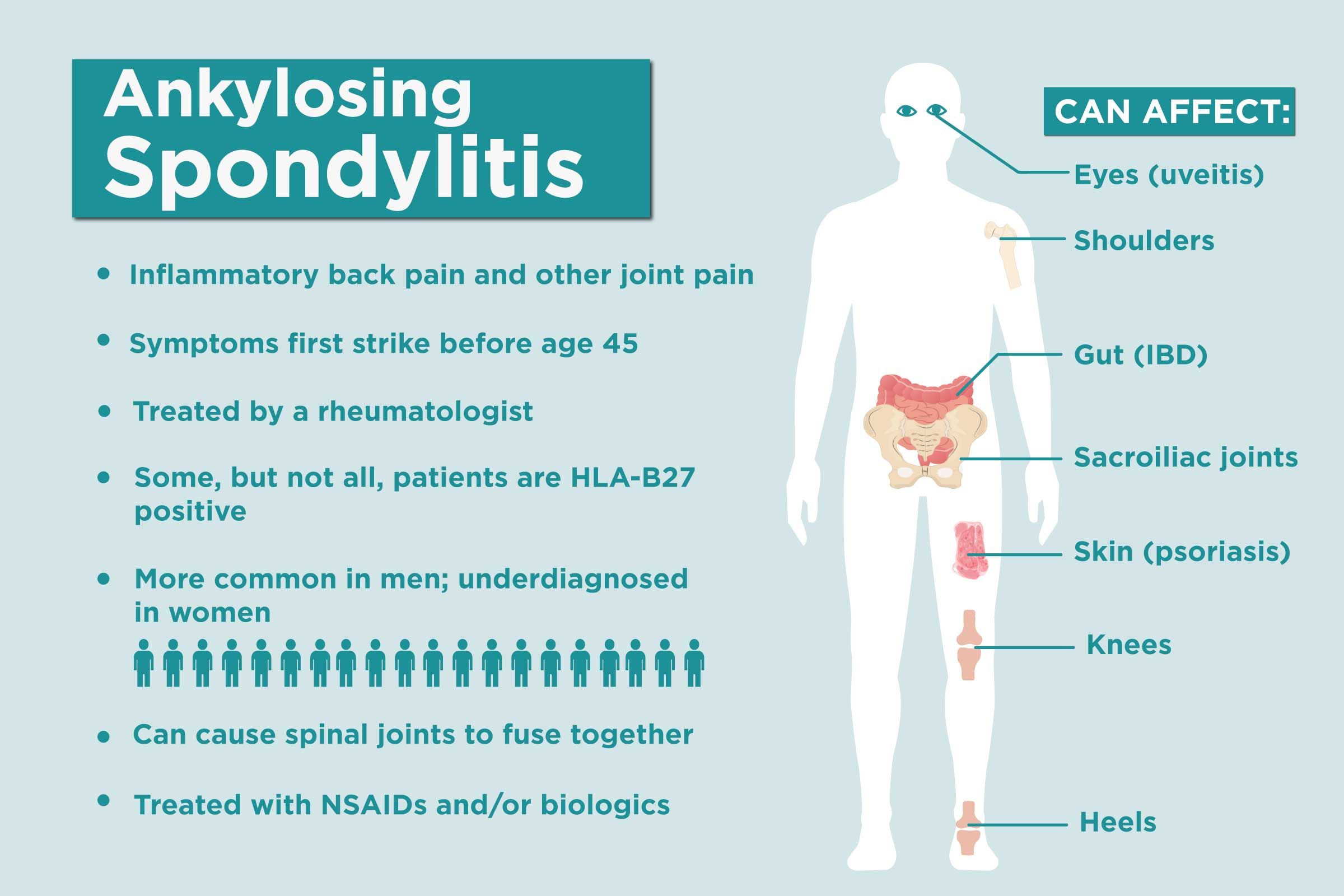
Treatment of ankylosing spondylitis in Israel
Treatment of ankylosing spondylitis in Israel | Hadassah Medical Center
Ankylosing spondylitis (Bekhterev’s disease) is a chronic disease in which the spine and other parts of the body become inflamed. The pathology is observed primarily in adolescents and young adults. It is approximately twice as common in men as in women.
The prognosis for ankylosing spondylitis is highly circumstantial. The patient’s condition can both improve after the initial attack of inflammation, and slowly but steadily worsen. Some patients with ankylosing spondylitis remain completely independent in the long term. The possibilities of others are limited to a minimal extent. It also happens that patients become severely disabled as a result of fusion of the bones of the spine and damage to other joints – for example, the hip or knee.
Thanks to the modern methods of treatment in Israel, ankylochal spondylitis usually does not significantly affect life expectancy . However, this disease increases the risk of developing other, potentially deadly pathologies. Possible complications of AS include thinning of the bones (osteoporosis), vertebral fractures, cardiovascular disease – disorders of the heart and blood vessels, chest infections, and, in rare cases, kidney disease.
However, this disease increases the risk of developing other, potentially deadly pathologies. Possible complications of AS include thinning of the bones (osteoporosis), vertebral fractures, cardiovascular disease – disorders of the heart and blood vessels, chest infections, and, in rare cases, kidney disease.
Ankylosing spondylitis is incurable and the damage it causes is irreversible. However, in Israel, special methods of treatment are used that alleviate the symptoms of the disease and prevent or slow down its progression.
Most of the patients at the Hadassah Clinic are prescribed a combination of therapies:
- Therapeutic exercise – classes are given both individually and in groups. Exercise reduces pain and stiffness;
- Physiotherapy – physical methods such as massage and manipulation increase the comfort and flexibility of the spine;
- Drug Therapy – Medications relieve pain and reduce inflammation. Ankylosing spondylitis is treated with pain medications, tumor necrosis factor inhibitors (anti-TNF drugs), and other forms of biological therapy.

Some patients require surgery to repair severely damaged joints or correct excessive curvatures in the spine, but in general, surgical treatment of ankylosing spondylitis is rarely used in Israel.
Ankylosing spondylitis specialists in Hadassah
Lead Immunologist and Rheumatologist
Professor
Renowned Israeli immunologist and rheumatologist, head of the commission of the Israeli Ministry of Health on cell and gene therapy. Treats autoimmune and rheumatological diseases.
Head of Rheumatology Department
Professor
Leading Israeli rheumatologist, professor with almost 40 years of experience, winner of several medical awards for outstanding achievements in the diagnosis and treatment of rheumatological diseases.
Head of the Rheumatology Center
Professor
Renowned Israeli rheumatologist, specialist in the treatment of autoimmune diseases with almost 30 years of experience, winner of several professional awards.
 Selects personalized treatment protocols.
Selects personalized treatment protocols.
Causes of the disease
Ankylosing spondylitis (AS) is an inflammation of certain elements in the lower part of the spine, including bones (vertebrae) and joints. Over time, inflammation damages the spine and causes new bone to grow. Because of this, some parts of the spine are connected (fused) and lose their flexibility (ankylosed). Scientists do not yet know why AS develops, but it is believed that this pathology has a connection with the HLA-B27 gene.
Researchers have found that 9 out of 10 patients with ankylosing spondylitis are carriers of a gene called “human leukocyte antigen B27” (HLA-B27). Having this gene does not necessarily mean that a person will get ankylosing spondylitis. Experts estimate that approximately 8 out of 100 people have the HLA-B27 gene, but most do not have AS. It is believed, however, that the presence of this gene indicates a predisposition to ankylosing spondylitis. The disease presumably begins to develop under the influence of one or more environmental factors, but scientists have not yet established their nature.
The disease presumably begins to develop under the influence of one or more environmental factors, but scientists have not yet established their nature.
If AS is suspected, patients in Israel are ordered to test for the HLA-B27 gene . However, such testing is not a reliable diagnostic method: a person can be a carrier of the HLA-B27 gene and not suffer from ankylosing spondylitis.
Ankylosing spondylitis can be passed down from generation to generation, and the HLA-B27 gene can be inherited from one of the relatives. If a person has AS and tests show they have the HLA-B27 gene, there is a 50% chance that they will pass the gene on to their child. It is estimated that 5-20% of children who inherit the HLA-B27 gene eventually develop ankylosing spondylitis.
Symptoms of ankylosing spondylitis
Symptoms of ankylosing spondylitis usually develop gradually over several months or years. Over the years, they can appear and pass, as well as weaken and intensify. As a rule, the disease begins to develop at the age of 20 to 30 years.
As a rule, the disease begins to develop at the age of 20 to 30 years.
Main symptoms:
- Pain and stiffness in the back. A person may notice that the pain decreases with physical exertion, but does not decrease or even increases during rest. The greatest stiffness and pain often disturb the patient in the morning and at night – some patients regularly wake up at night due to pain. Many patients have pain in the area around the buttocks.
- Arthritis. Ankylosing spondylitis causes not only symptoms in the back and spine, but also inflammation of the joints in other parts of the body. For example, the hip or knee joints may be affected. The main symptoms of arthritis include pain when moving the affected limb, tenderness on examination of the affected joint, swelling and a feeling of warmth in the affected area.
- Enthesit. This is a painful inflammation at the junction of a bone with a tendon or ligament.
 Most often, enthesitis develops in the upper part of the tibia, the back of the heel (Achilles tendon), the area under the heel, the junction of the ribs with the sternum. When the ribs are affected, chest pains and difficulty in expanding the chest during a deep breath are observed.
Most often, enthesitis develops in the upper part of the tibia, the back of the heel (Achilles tendon), the area under the heel, the junction of the ribs with the sternum. When the ribs are affected, chest pains and difficulty in expanding the chest during a deep breath are observed. - Fatigue. Fatigue is a common symptom of advanced ankylosing spondylitis. Patients feel a breakdown and lack of energy.
Diagnosis of ankylosing spondylitis in the Hadassah Clinic
Ankylosing spondylitis is difficult to diagnose, since the disease develops slowly, and there is no exact way to detect it. But Bechterew’s disease is characterized by very specific back pain. For example, it does not go away after rest and can wake a person at night.
In order to make a diagnosis, the Hadassah clinic specialists perform a series of examinations starting with blood tests. If suspected, the doctor will prescribe blood tests to detect signs of inflammation in the body.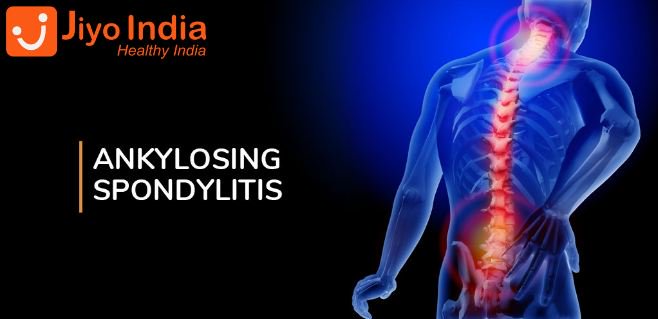 Inflammation in the spine and joints is the main symptom of ankylosing spondylitis.
Inflammation in the spine and joints is the main symptom of ankylosing spondylitis.
The rheumatologist will also order imaging tests and check how the spine and pelvis look. Methods for more in-depth diagnostics include:
- Radiography;
- MRI;
- Ultrasound.
The genetic blood test determines if a patient has the HLA-B27 gene, which is present in most patients with ankylosing spondylitis. The results of such an analysis can help identify Bechterew’s disease, but this is not a completely reliable method of diagnosis. Not all patients with AS have the HLA-B27 gene, and not all carriers of the gene develop ankylosing spondylitis.
Although x-rays sometimes show inflammation and fusion (ankylosis) of the bones of the spine, it is not always possible to detect obvious damage in the early stages of AS. For this reason, the diagnosis of the disease is often difficult. But in Hadassah, patients get an appointment with the best Israeli rheumatologists who have impressive experience in both diagnosing and treating Bechterew’s disease. This is a guarantee of the accuracy of the diagnosis.
This is a guarantee of the accuracy of the diagnosis.
The diagnosis of ankylosing spondylitis is usually confirmed by evidence of inflammation of the sacroiliac joints (sacroiliitis) on x-ray and the presence of at least one of the following:
- Low back pain that persists for at least three months, improves with exercise and does not improve with rest;
- Limited range of motion in the lower back;
- Incomplete expansion of the chest, taking into account the age and sex of the patient.
Ankylosing spondylitis treatment methods used by Hadassah rheumatologists
Ankylosing spondylitis is incurable, but some therapies used by Israeli specialists can relieve its symptoms. Treatment also helps to delay or prevent bone fusion and spinal rigor mortis. Most patients are prescribed a combination of several treatment options at once.
Therapeutic exercise and physiotherapy
Physical activity improves posture and increases range of motion in the spine. In addition, it prevents the spine from losing flexibility and becoming painful. In the treatment of ankylosing spondylitis, not only activity, but also physical therapy plays a key role. The Physical Therapist at Hadassah will recommend the most effective exercises to the patient and design an exercise plan tailored to their individual needs.
In addition, it prevents the spine from losing flexibility and becoming painful. In the treatment of ankylosing spondylitis, not only activity, but also physical therapy plays a key role. The Physical Therapist at Hadassah will recommend the most effective exercises to the patient and design an exercise plan tailored to their individual needs.
For patients with ankylosing spondylitis, the following types of physical therapy are indicated in Israel:
- Group exercises – doing exercises together with other patients;
- Individual lessons – self-execution of exercises;
- Massage – manipulation of muscles and other soft tissues to relieve pain and facilitate movement; manipulations should in no case affect the bones of the spine, since patients with AS can be injured because of this;
- Hydrotherapy – exercises in water, usually carried out in a warm shallow pool or in a special hydrotherapy bath; water supports the body due to the force of expulsion and thereby facilitates movement; the heat at this time relaxes the muscles.

Some people prefer to swim or play sports to stay flexible. This is also a good option, but it does not replace daily exercise and stretching.
Medical treatment
Many patients with Bechterew’s disease require pain medication:
- Non-steroidal anti-inflammatory drugs (NSAIDs). Non-steroidal anti-inflammatory drugs (NSAIDs) are usually recommended first for patients. NSAIDs not only relieve pain but also reduce swelling (inflammation) in the joints. NSAIDs include ibuprofen, naproxen, diclofenac, etoricoxib. When prescribing an NSAID, the Hadassah rheumatologist will try to select the drug that is most suitable for the patient and recommend the lowest effective dose. The doctor will monitor the dosage of NSAIDs and revise it if necessary.
- Paracetamol. If NSAIDs are not suitable for the patient, the doctor may prescribe an alternative pain reliever – paracetamol. Paracetamol rarely causes side effects.
 It can be used during pregnancy and lactation. On the other hand, this drug is contraindicated in liver pathologies and alcohol dependence.
It can be used during pregnancy and lactation. On the other hand, this drug is contraindicated in liver pathologies and alcohol dependence. - Codeine. If necessary, patients with AS are prescribed not only paracetamol, but also a stronger analgesic drug – codeine.
Biological Therapy
In Israel, patients often have access to the latest medicines available on the pharmaceutical market, such as biological therapies.
- Anti-TNF drugs. If painkillers, exercise, and stretching do not help with AS symptoms, patients in Israel are prescribed tumor necrosis factor (TNF) inhibitors. TNF is a chemical produced by cells when tissues become inflamed. Anti-TNF drugs are intended for injection. They neutralize the action of TNF and reduce inflammation in the joints caused by ankylosing spondylitis. These are relatively new drugs for ankylosing spondylitis and have not yet been evaluated in the long term. However, in rheumatoid arthritis, they are used even longer, and therefore doctors have basic information about the long-term safety of such drugs.
 If the rheumatologist believes that an anti-TNF drug will help the patient, he will discuss the nuances of therapy with him in detail and establish careful monitoring of the patient’s condition.
If the rheumatologist believes that an anti-TNF drug will help the patient, he will discuss the nuances of therapy with him in detail and establish careful monitoring of the patient’s condition.
In rare cases, anti-TNF drugs disrupt the immune system and increase the risk of contracting potentially serious infectious diseases. If there is no significant improvement after three months of anti-TNF therapy, the drug will be discontinued. - Secukinumab. Secukinumab is a drug that is used for AS when NSAIDs or anti-TNF drugs have failed. Secukinumab blocks the action of a protein involved in the development of inflammation.
Corticosteroids and disease-modifying antirheumatic drugs
Corticosteroids are powerful anti-inflammatory agents and are available in both tablet and injectable form.
If a specific joint is inflamed, corticosteroids are injected directly into the affected tissue. After the injection, it is necessary to provide the joint with rest for up to 48 hours.
Corticosteroid injections are generally given no more than three times a year. In addition, an interval of at least three months should be observed between injections in the same joint.
Corticosteroid injections can cause side effects such as:
- infection in response to the drug;
- discoloration (discoloration) of the skin at the injection site;
- depletion of surrounding tissues;
- tendon rupture adjacent to the joint.
Corticosteroid tablets have a soothing effect on painful, swollen joints.
Disease-modifying antirheumatic drugs (DMARDs) are alternative medicines used in the treatment of other types of arthritis. DMARDs are also prescribed for ankylochus spondylitis, although they only help with pain and inflammation in the joints located in any part of the body except the spine. Sulfasalazine is the main DMARD used for joint inflammation in any part of the body except the spine
Surgery
Most patients with ankylosing spondylitis do not require surgery.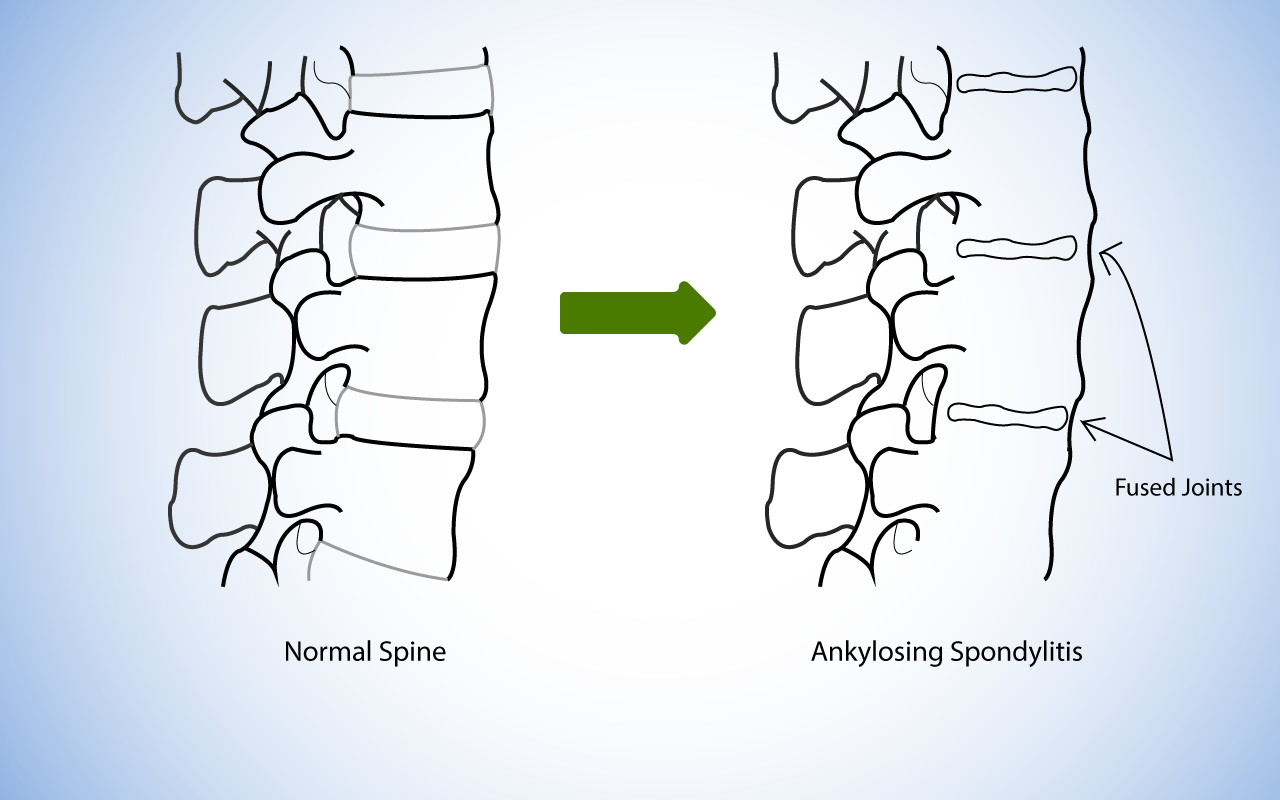


 Selects personalized treatment protocols.
Selects personalized treatment protocols. Most often, enthesitis develops in the upper part of the tibia, the back of the heel (Achilles tendon), the area under the heel, the junction of the ribs with the sternum. When the ribs are affected, chest pains and difficulty in expanding the chest during a deep breath are observed.
Most often, enthesitis develops in the upper part of the tibia, the back of the heel (Achilles tendon), the area under the heel, the junction of the ribs with the sternum. When the ribs are affected, chest pains and difficulty in expanding the chest during a deep breath are observed.
 It can be used during pregnancy and lactation. On the other hand, this drug is contraindicated in liver pathologies and alcohol dependence.
It can be used during pregnancy and lactation. On the other hand, this drug is contraindicated in liver pathologies and alcohol dependence. If the rheumatologist believes that an anti-TNF drug will help the patient, he will discuss the nuances of therapy with him in detail and establish careful monitoring of the patient’s condition.
If the rheumatologist believes that an anti-TNF drug will help the patient, he will discuss the nuances of therapy with him in detail and establish careful monitoring of the patient’s condition.